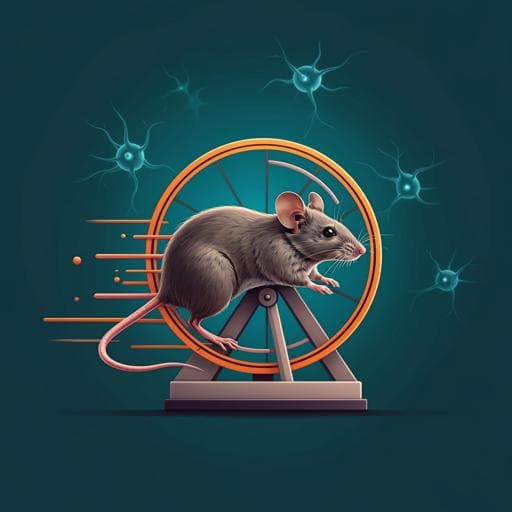
Medicine and Health
Appropriate exercise level attenuates gut dysbiosis and valeric acid increase to improve neuroplasticity and cognitive function after surgery in mice
Z. Lai, W. Shan, et al.
This cutting-edge research by Zhongmeng Lai and colleagues revealed that low-intensity exercise effectively combats postoperative cognitive dysfunction (POCD) in mice. By reducing gut microbiota alterations and neuroinflammation, exercise promotes cognitive recovery, showcasing its potential as a therapeutic strategy for enhancing brain health after surgery.
~3 min • Beginner • English
Introduction
POCD affects millions of patients and is associated with adverse outcomes; advanced age is an independent risk factor. Neuroinflammation is implicated in POCD pathogenesis, potentially triggered by peripheral surgery-induced systemic inflammation transmitted to the brain. Gut microbiota regulates inflammation, and dysbiosis has been associated with post-surgical learning and memory deficits in animals; probiotics may improve cognition, but direct causal evidence for gut microbiota in POCD is lacking. Exercise and environmental enrichment can mitigate surgery-induced cognitive impairment, and the microbiome may modulate responsiveness to exercise in metabolic contexts. The authors hypothesized that an appropriate (low) level of exercise attenuates surgery-induced neuroinflammation and cognitive impairment and that these effects are mediated by gut microbiota alterations. They further posited that specific microbial metabolites (notably valeric acid) and downstream signaling (complement C3/C3aR, astrocyte phenotype, and growth factors like GDNF) mediate these effects. The study tested these hypotheses in adult and old mice undergoing a standardized carotid artery exposure surgery.
Literature Review
- Epidemiology: POCD is common and linked to increased mortality and hospitalization costs; age is a key risk factor (refs 1–5).
- Mechanisms: Neuroinflammation plays a critical role; peripheral surgery induces systemic inflammation leading to brain neuroinflammation and POCD (refs 6–9).
- Gut microbiota: Regulates inflammation; dysbiosis associates with post-surgical cognitive deficits in animals; probiotics can improve cognition, but causality wasn’t directly shown prior to this study (refs 10–13).
- Exercise/environment: Environmental enrichment reduces surgery-induced cognitive deficits, potentially via increased physical activity (refs 14–15). Exercise improves human long-term memory and may lessen cognitive decline post-cardiac surgery; in low-capacity rats, exercise attenuated neuroinflammation and improved microbiota, though not all models show cognitive protection (refs 16–19).
- SCFAs and brain: Microbial SCFAs can modulate brain function, immunity, and gene expression, often treated as a group in prior work; specific roles of valeric acid were unclear (refs 27–31).
Methodology
Design: Male C57BL/6J mice (young: 8–9 weeks; old: 18–19 months) underwent individualized maximal exercise capacity determination, followed by 4 weeks of treadmill running at low (35–40%), middle (55–60%), or high (75–80%) intensity, 5 days/week. Surgery was a 15-min left carotid artery exposure under 2% isoflurane (total anesthesia ~2 h). Outcomes included behavior, microbiota profiling, SCFAs quantification, neuroinflammation markers, neuroplasticity measures, and mechanistic interventions.
Behavioral assays: Novel object recognition (NOR; short-term 30 s and long-term 24 h delays) starting 4 days post-surgery; Barnes maze (4 training days; memory tests on days 5 and 12 post-training).
Microbiota: Fecal 16S rRNA V3–V4 amplicon sequencing (Illumina MiSeq); alpha and beta diversity analyses, LDA effect size; antibiotics (amoxicillin/clavulanate, metronidazole, cefazolin) used to deplete native microbiota prior to fecal microbiota transplantation (FMT). FMT prepared by pooling feces from 7–10 donors per condition; administered by gastric gavage and enema once daily for 7 days; recipients rested 2 weeks before testing.
SCFAs: Plasma SCFAs measured by GC–MS; fecal SCFAs also assessed; cortical valeric acid quantified by HPLC after derivatization.
Molecular and histological analyses: RNA-seq and qPCR (hippocampus) to assess gene expression (focus on C3ar1). Immunostaining and ELISAs for Iba-1, C3, C3aR, IL-1β, IL-6, and GDNF. BrdU injections to label proliferating cells; GFAP co-labeling. Golgi staining for dendritic arborization (Sholl analysis) and spine density. Western blotting for PSD95 and synapsin-1.
Interventions: Intraperitoneal valeric acid (200 mg/kg weekly during exercise; additional dose on surgery day); intracerebroventricular (ICV) injections of C3aR antagonist SB290157 or C3aR agonist (0–72 h post-surgery), GDNF or heat-inactivated GDNF at surgery, and low-dose ICV valeric acid in a separate experiment. Old mice underwent analogous protocols at low-intensity exercise.
Statistics: Two-way repeated ANOVA for Barnes maze training, various ANOVA/t-tests or non-parametric tests for other outcomes; significance at P<0.05. No adjustments for multiple comparisons; sample sizes based on prior experience; at least three experimental replicates per condition.
Key Findings
- Exercise intensity effect: Surgery impaired learning and memory; only low-intensity (35–40% capacity) exercise prevented these deficits. Barnes maze training showed a significant surgery effect [F(1,113)=7.360, P=0.008]; low-intensity exercise reversed the effect [interaction F(1,76)=5.278, P=0.024]. Post-training memory latencies were improved by low-intensity but not middle/high intensity. NOR deficits (both 30 s and 24 h delays) induced by surgery were prevented by low-intensity exercise.
- Fecal microbiota transplantation (FMT): Transplanting feces from exercise mice into antibiotic-treated recipients improved Barnes maze performance [training F(1,26)=13.071, P=0.001] and NOR after surgery, indicating gut microbiota mediates exercise benefits. Conversely, feces from surgery mice transferred to controls induced cognitive deficits versus feces from controls.
- Microbiota composition: Exercise increased alpha diversity and altered beta diversity; enriched Bacteroidetes (e.g., Bacteroidales, Alistipes) and reduced Firmicutes (lactobacillaceae, Lactobacillus). Surgery reduced diversity at 7 days; exercise stabilized diversity after surgery. FMT recapitulated donor microbiota features.
- Neuroinflammation and complement signaling: Surgery increased hippocampal C3, C3aR, Iba-1, and IL-6; exercise attenuated these increases. IL-1β showed no significant change in some young cohorts. RNA-seq/qPCR identified increased C3ar1 after surgery, reversed by exercise and by FMT from exercise donors.
- Neuroplasticity: Surgery reduced BrdU+ cell genesis (including GFAP+), dendritic intersections, spine density, PSD95, and synapsin-1. Exercise prevented these changes; FMT from exercise donors preserved neurogenesis and synaptic proteins.
- SCFAs and valeric acid: In young mice pre-surgery, exercise decreased plasma valeric acid (only SCFA reduced at baseline). At 7 days post-surgery, surgery increased plasma valeric acid; exercise attenuated this increase. In addition, exercise altered other SCFAs in young surgery mice (propionic, butyric, hexanic decreased; acetic, isobutyric, isovaleric increased). Blood valeric acid positively correlated with Lactobacillus and Anaerotruncus and negatively with Alistipes. FMT from exercise donors lowered recipient plasma valeric acid. Fecal SCFAs did not mirror blood changes.
- Valeric acid causality: Intraperitoneal valeric acid blocked exercise’s protective effects on Barnes maze and NOR in young and old mice with surgery; low-dose ICV valeric acid (1/50 i.p. dose) did not impair cognition. i.p. valeric acid increased brain (cortex) valeric acid at 24 h and elevated hippocampal C3.
- Complement C3aR manipulation: ICV C3aR antagonist SB290157 improved cognition after surgery; C3aR agonist worsened cognition in exercised surgery mice, implicating C3 signaling in POCD.
- GDNF: Surgery decreased hippocampal GDNF; exercise and FMT from exercise donors preserved GDNF. i.p. valeric acid reduced GDNF and increased brain C3. ICV GDNF (but not heat-inactivated) reduced hippocampal C3, IL-6, and IL-1β after surgery, linking growth factor preservation to reduced neuroinflammation.
- Old mice: Low-intensity exercise attenuated surgery-induced cognitive deficits; FMT from old exercise donors improved cognition versus FMT from old controls. Surgery increased plasma valeric acid; exercise reduced it in old surgery mice. Exercise attenuated increases in hippocampal C3/C3aR/Iba-1/IL-1β/IL-6, preserved GDNF, neurogenesis, dendritic arborization, spine density, and synaptic proteins in old mice. Valeric acid administration negated exercise benefits.
Discussion
The study directly demonstrates that gut microbiota alterations contribute causally to POCD and that appropriate low-intensity exercise mitigates surgery-induced cognitive decline through microbiota-dependent mechanisms. Exercise stabilized post-surgical gut microbiota, shifted taxa toward Bacteroidetes (e.g., Alistipes) and away from Firmicutes (e.g., Lactobacillus), and lowered circulating valeric acid, a specific SCFA linked to worse cognitive and neuroinflammatory outcomes. Mechanistically, reduced blood valeric acid associated with decreased hippocampal complement C3/C3aR signaling, attenuated microglial activation and cytokines, maintenance of an A2 astrocyte phenotype, preservation of GDNF, and improved neurogenesis and synaptic structure. Pharmacological manipulations supported causality: systemic valeric acid reversed exercise benefits and increased brain C3; central C3aR antagonism rescued, and agonism impaired, cognition; GDNF reduced neuroinflammatory mediators. These convergent lines of evidence indicate a gut microbiota–valeric acid–C3 signaling axis, with GDNF and astrocyte phenotype as important downstream modulators, mediating exercise’s neuroprotective effects in both adult and aged mice. The findings highlight the importance of exercise intensity, with only low-intensity training conferring protection, and underscore blood SCFAs as more informative than fecal levels for brain-related outcomes.
Conclusion
Low-intensity, individualized exercise before surgery stabilizes gut microbiota, prevents a surgery-induced rise in blood valeric acid, dampens complement C3/C3aR-mediated neuroinflammation, preserves GDNF, and maintains neurogenesis and synaptic plasticity, thereby attenuating POCD in adult and old mice. Fecal microbiota from exercised donors transfers these benefits, and systemic valeric acid blocks them, establishing a causal gut–brain pathway. Potential translational strategies include prehabilitation with appropriate-intensity exercise, microbiota-targeted interventions (e.g., FMT or probiotics tailored to enrich beneficial taxa), and modulation of complement signaling. Future research should define the precise molecular targets of valeric acid, identify safe approaches to lower circulating valeric acid in humans, determine why higher-intensity exercise lacks benefit, and evaluate these interventions clinically.
Limitations
- Mechanistic detail: The precise molecular mechanisms by which valeric acid worsens brain outcomes were not fully delineated beyond linking to C3/C3aR activation; direct central effects were not definitively established as low-dose ICV valeric acid was inconclusive.
- Exercise intensity: The study did not investigate why middle/high-intensity exercise failed to protect against POCD.
- FMT design: Donor feces were pooled (7–10 donors), which may obscure individual donor effects and host–donor matching influences.
- Statistical considerations: Sample size calculations were not performed a priori, and adjustments for multiple comparisons were not applied.
- Generalizability: Findings are in male mice and a single surgery model; translation to humans requires validation.
- SCFAs measurement: Blood, not fecal, SCFAs reflected relevant changes; mechanisms governing absorption/metabolism leading to blood–feces discrepancies were not explored.
Related Publications
Explore these studies to deepen your understanding of the subject.







